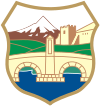Related Research Articles

The Candar dynasty or the House of Candar, Beylik of Candar, Principality of Candar, also known as the Isfendiyar dynasty (İsfendiyaroğulları) or Beylik of Isfendiyar, is an Oghuz Turkic princely Anatolian dynasty that reigned in the territories corresponding to the provinces of Eflani, Kastamonu, Sinop, Zonguldak, Bartın, Karabük, Samsun, Bolu, Ankara and Çankırı in present-day Türkiye from the year 1291 to 1461. The region was known in Western literature as Paphlagonia, a name applied to the same geographical area during the Roman period.

Hurufism was a Sufi movement based on the mysticism of letters (ḥurūf), which originated in Astrabad and spread to areas of western Iran (Persia) and Anatolia in the late 14th and early 15th centuries.
Karposh’s rebellion or Karposh’s uprising was a Christian anti-Ottoman uprising in the Central Balkans that took place in October 1689. Karposh, the rebellion leader, was born in the Sanjak of Üsküp in the then Rumelia Eyalet, Ottoman Empire, modern North Macedonia, probably in the village of Vojnik, under the name Petar. At a very young age, he escaped to Wallachia, present-day Romania, where he worked as a miner. Later, Karposh moved to the Rhodope Mountains, where he settled in the Dospat valley, becoming a notorious hajduk. After the army of the Holy Roman Empire advanced into the Ottoman Balkans, Karposh moved to the area of Znepole, and began to organise anti-Ottoman resistance detachments here.

The House of Kosača, somewhere Kosačić, was a Bosnian medieval noble family which ruled over parts of modern-day Bosnia and Herzegovina, Croatia, Montenegro, and Serbia between the 14th century and the 15th century. The land they controlled was known as Humska zemlja, roughly corresponding to modern region of Herzegovina, which itself was derived from the title "Herzog", which Stjepan Vukčić Kosača adopted in 1448., with latin title "Dux Sancti Sabbae". Besides Hum, they ruled parts of Dalmatia and Rascia. They were vassals to several states, including the Kingdom of Bosnia and Ottoman Empire. Historians think the Kosača family is part of the Kőszegi family, but there is a lack of evidence for this claim.
The religious confession of the Kosača family is uncertain. They were in contact with the Eastern Orthodox Church, the Church of Bosnia, the Roman Catholic Church and Islam. During the fall of the Bosnian Kingdom, the "Kosače" split into three branches: Venetian, Dalmatian and Ottoman. From then onward, these branches became accepting of the Roman Catholic faith, in the first two cases, and of Islam in the third.
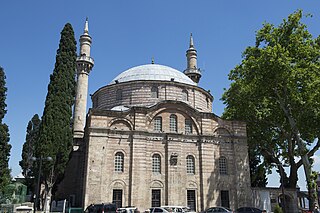
The Emir Sultan Mosque is in Bursa, Turkey. First built in the 15th century, it was rebuilt in 1804 for the Ottoman sultan Selim III, and rebuilt again in 1868, the plan of the mosque changing slightly with each rebuild.

Andon Lazov Yanev, nicknamed Kyoseto, was a Bulgarian revolutionary and a freedom fighter of the Internal Macedonian-Adrianople Revolutionary Organization (IMARO). Although he identified as Bulgarian, according to the historiography in North Macedonia, he was an ethnic Macedonian.
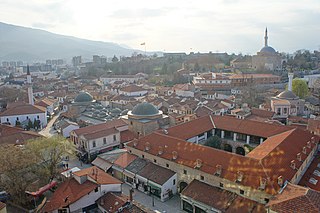
The Old Bazaar also known as Turkish Bazaar is a bazaar located in Skopje, North Macedonia, situated on the eastern bank of the Vardar River, stretching from the Stone Bridge to the Bit-Pazar and from the Skopje Fortress to the Serava river. The Old Bazaar falls primarily within the borders of Čair Municipality but a part of it is located in Centar Municipality. As one of the oldest and largest marketplaces in the Balkans, it has been Skopje's centre for trade and commerce since at least the 12th century.

Aziz Mahmud Hudayi (1541–1628),, is amongst the most famous Sufi Muslim saints of the Ottoman Empire. A mystic, poet, composer, author, statesman and Hanafi Maturidi Islamic scholar, he was the third and last husband of Ayşe Hümaşah Sultan, granddaughter of Sultan Suleiman the Magnificent.
Şemsi Pasha, also known as Chamsi-Pasha, was a distinguished Ottoman nobleman and beylerbey who occupied several high-ranking posts, serving at various stages as the Ottoman governor-general of the beylerbeyliks of Damascus, Anatolia and Rumeli.
North Macedonia was part of the Ottoman Empire for over five hundred years, from the late 14th century to the Treaty of Bucharest (1913). Before its conquest, this area was divided between various Serbian feudal principalities. Later, it became part of the Ottoman province or Eyalet of Rumelia. The name Rumelia means "Land of the Romans" in Turkish, referring to the lands conquered by the Ottoman Turks from the Byzantine Empire.
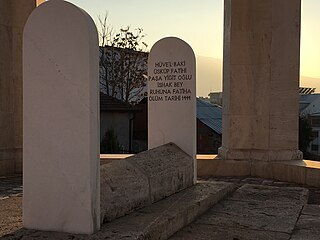
Ishak Bey or Ishak-Beg or Ishak-Beg Hranić was an Ottoman governor and soldier, the sanjakbey of Üsküb from 1415 to 1439.
Pasha Yiğit Bey or Saruhanli Pasha Yiğit Bey was an Ottoman civil and military officer at the end of the 14th and beginning of the 15th century.

The Sanjak of Üsküp was one of the sanjaks in the Ottoman Empire, with Üsküb as its administrative centre.

The Sultan Murad Mosque is an Ottoman-era mosque in Skopje, North Macedonia. It was built in the 15th century on top of the Monastery of Saint George which was destroyed when Ottoman commander Pasha Yiğit Bey captured Skopje from Vuk Branković in 1392.
The following is a timeline of the history of the city of Skopje, North Macedonia.
Turahanoğlu family was one of the families that led the akıncı corps in Ottoman Empire between the 15th-16th centuries.
Ayşe Hümaşah Sultan was an Ottoman princess, the only daughter of Mihrimah Sultan and Rüstem Pasha. She had a younger brother, Sultanzade Osman Bey. She was granddaughter of Sultan Suleiman the Magnificent (1520–1566) and his favorite consort and legal wife, Hurrem Sultan, and their first grandchild.
The Siege of Kulaca Hisar or Raid of Kulaca Hisar was a battle fought between the Byzantines and the Turks under the command of Osman Gazi in 1285.
List of historical tekkes, zawiyas, and dergahs in Istanbul, Turkey:
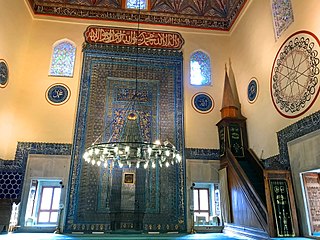
Early Ottoman architecture corresponds to the period of Ottoman architecture roughly up to the 15th century. This article covers the history of Ottoman architecture up to the end of Bayezid II's reign, prior to the advent of what is generally considered "classical" Ottoman architecture in the 16th century. Early Ottoman architecture was a continuation of earlier Seljuk and Beylik architecture while also incorporating local Byzantine influences. The new styles took shape in the capital cities of Bursa and Edirne as well as in other important early Ottoman cities such as Iznik. Three main types of structures predominated in this early period: single-domed mosques, "T-plan" buildings, and multi-domed buildings. Religious buildings were often part of larger charitable complexes (külliyes) that included other structures such as madrasas, hammams, tombs, and commercial establishments.
References
- ↑ Judah (2009). The Serbs: History, Myth and the Destruction of Yugoslavia. Yale University Press. p. 46. ISBN 978-0-300-15826-7.
- 1 2 Asani, Eljesa (10 March 2010). "Makedonya'daki medreseler ve İsa Bey Medresesi" (in Turkish).
{{cite journal}}: Cite journal requires|journal=(help) - ↑ "History of Skopje". www.fidanoski.ca. Retrieved 21 June 2017.
- ↑ Скопје, Град. "Official portal of City of Skopje – History". www.skopje.gov.mk. Retrieved 27 November 2017.
- ↑ Katardzhiev, Ivan (1979). A History of the Macedonian People. Translated by Graham W. Reid. Skopje: Macedonian Review. p. 96.
- ↑ "ÜSKÜP - TDV İslâm Ansiklopedisi". TDV İslam Ansiklopedisi (in Turkish). Retrieved 12 March 2022.
- ↑ "İshak Bey Camii | Etnolojik Araştırmalar ve Uygulamalı Antropoloji Merkezi - CEIPA". ceipa.pmf.ukim.mk. Retrieved 12 March 2022.
- ↑ Yasinyazdı (19 September 2016). "Yahya Paşa Cami". Üsküp - Makedonya Üsküp Şehri Turizm Rehberi (in Turkish). Retrieved 12 March 2022.
- ↑ "SULTAN MURAD KÜLLİYESİ - TDV İslâm Ansiklopedisi". TDV İslam Ansiklopedisi (in Turkish). Retrieved 12 March 2022.
- 1 2 creativeyazilim.com, Creative Yazılım-. "Üsküp - Dünya Sırtımda | Düşük Bütçeli Seyahat Rehberi". dunyasirtimda.com. Retrieved 12 March 2022.
- ↑ Camci, +hali̇t Ömer (28 May 2008). "Üsküp Yıldırım Han Diyarı – Bize Ataların Yadigârı". Gezgin Dergi (in Turkish). Retrieved 12 March 2022.
- ↑ "Üsküp'te Tarihi ve Turistik Yerler | 16 Tarihi Yer". Biletbayi Blog (in Turkish). 22 June 2021. Retrieved 12 March 2022.
- ↑ "Sami Altınay'ın Üsküp Rehberi | Uzakrota".
- ↑ Skopje In Your Pocket. In Your Pocket.
